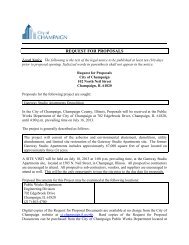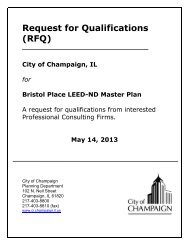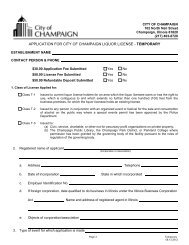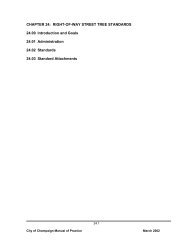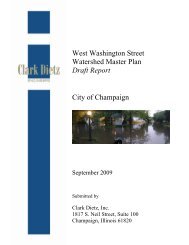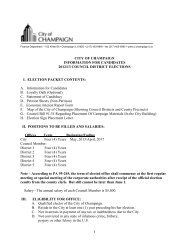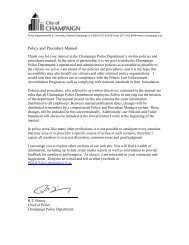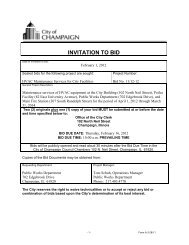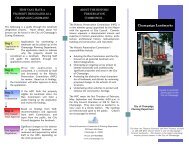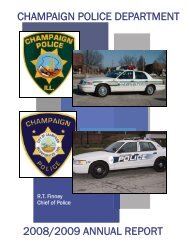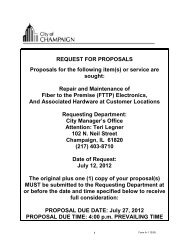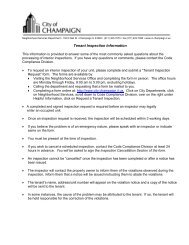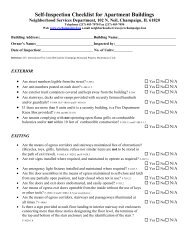2010-2014 Consolidated Plan - City of Champaign
2010-2014 Consolidated Plan - City of Champaign
2010-2014 Consolidated Plan - City of Champaign
Create successful ePaper yourself
Turn your PDF publications into a flip-book with our unique Google optimized e-Paper software.
FY <strong>2010</strong>/11 AAP Chapter 3:Affordable Housing Activities to be UndertakenThe following chapter provides a description <strong>of</strong> the affordable housing activities that the <strong>City</strong> <strong>of</strong> <strong>Champaign</strong>plans to carry out during the next year to address priority goals and strategies included in the five-year<strong>Consolidated</strong> <strong>Plan</strong> and the <strong>City</strong>’s Neighborhood Wellness <strong>Plan</strong>. Also included in this chapter are strategiesfor addressing public housing needs, affordable housing for persons with special needs, and residentiallead-based paint concerns. Some <strong>of</strong> these strategies outlined below will be carried out by the <strong>City</strong>’sNeighborhood Services Department through the use <strong>of</strong> federal Community Development Block Grant andHOME funds. However, both <strong>City</strong> staffing and financial resources are limited and therefore the <strong>City</strong> willrely on the following set <strong>of</strong> objectives to facilitate the successful implementation <strong>of</strong> the goals in this planand optimize the impact on neighborhoods.• Concentrate affordable housing and neighborhood improvement activities in areas identified as havingthe greatest needs. These areas include census tracts or Neighborhood Wellness <strong>Plan</strong>ning Areas withhigh concentrations <strong>of</strong> low- and moderate-income families, deteriorated and aging housing stock, anddeclining property values.• Employ proactive measures to reduce the decline <strong>of</strong> the <strong>City</strong>’s oldest neighborhoods throughrenovation <strong>of</strong> neighborhood housing infrastructure, construction <strong>of</strong> compatible in-fill housing, andacquisition/clearance <strong>of</strong> blighted land and dwellings.• Empower residents to continue to play a role in the preservation <strong>of</strong> neighborhoods through educationalefforts and the organization <strong>of</strong> neighborhood groups.• Foster partnerships with non-pr<strong>of</strong>it developers, Community Housing Development Organizations(CHDOs), as well as other agencies and local units <strong>of</strong> government to expand the <strong>City</strong>’s ability to carryout the affordable housing and community development strategies identified in this plan.• Continue to seek additional funding through federal, state, local or private resources to expand servicedelivery. Support projects carried out by non-pr<strong>of</strong>it developers that leverage additional resources tomaximize the impact <strong>of</strong> the <strong>City</strong>’s funding.Activities <strong>Plan</strong>nedFollowing each <strong>of</strong> the Goals and Objectives is a listing <strong>of</strong> activities that will be undertaken in the upcomingyear to achieve the stated objectives. Some <strong>of</strong> the activities can be carried out within one year, othersmay take longer to complete. Where resources have been identified to carry out the activities, those areindicated in parentheses after each activity. Some <strong>of</strong> the new initiatives are only in the planning stages, soa funding resource or potential numbers served may not yet be identified. For each activity that will becarried out with federal funds, a corresponding Project Table is provided in the Annual Action <strong>Plan</strong> Chapter6.Goals and ObjectivesGoal 1: Preserve the <strong>City</strong>’s housing infrastructure as a valuable community asset. TheNeighborhood Wellness <strong>Plan</strong> identifies several <strong>Plan</strong>ning Areas where the condition <strong>of</strong> the housing stock andthe value <strong>of</strong> property are not keeping pace with the rest <strong>of</strong> the <strong>City</strong>. Household incomes in theseneighborhoods are well below the area median. The inability to receive a reasonable return creates adisincentive for private investment. Private efforts must be supplemented with public investment if thehousing stock is going to remain a viable component <strong>of</strong> the neighborhood infrastructure.106 FY <strong>2010</strong>/11 Annual Action <strong>Plan</strong>: Affordable Housing Activities



